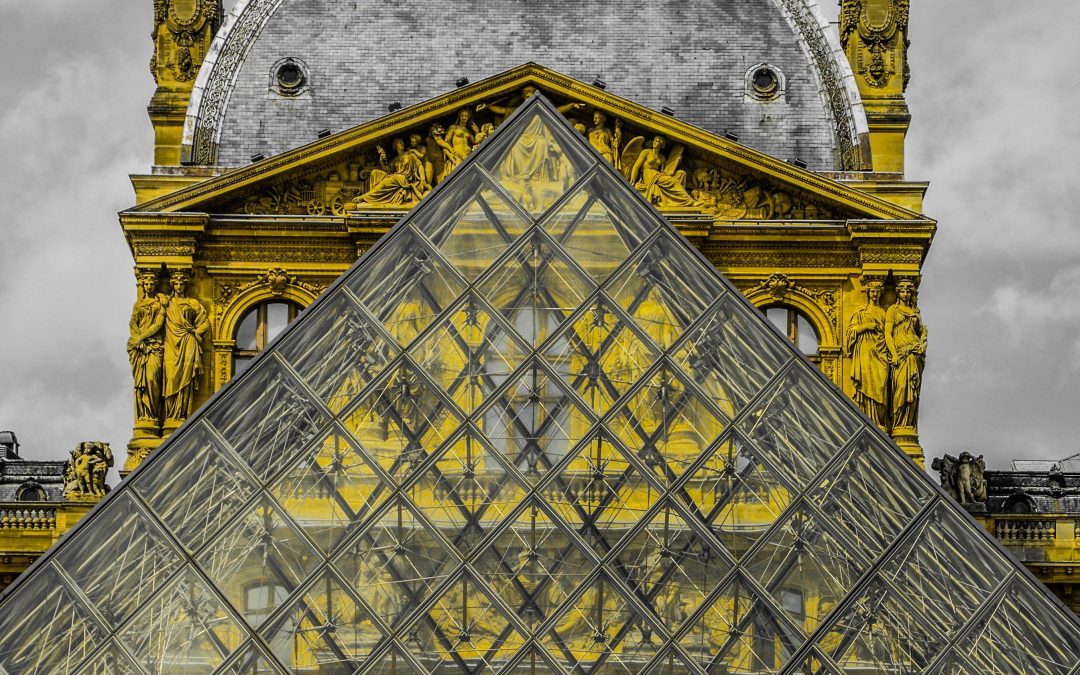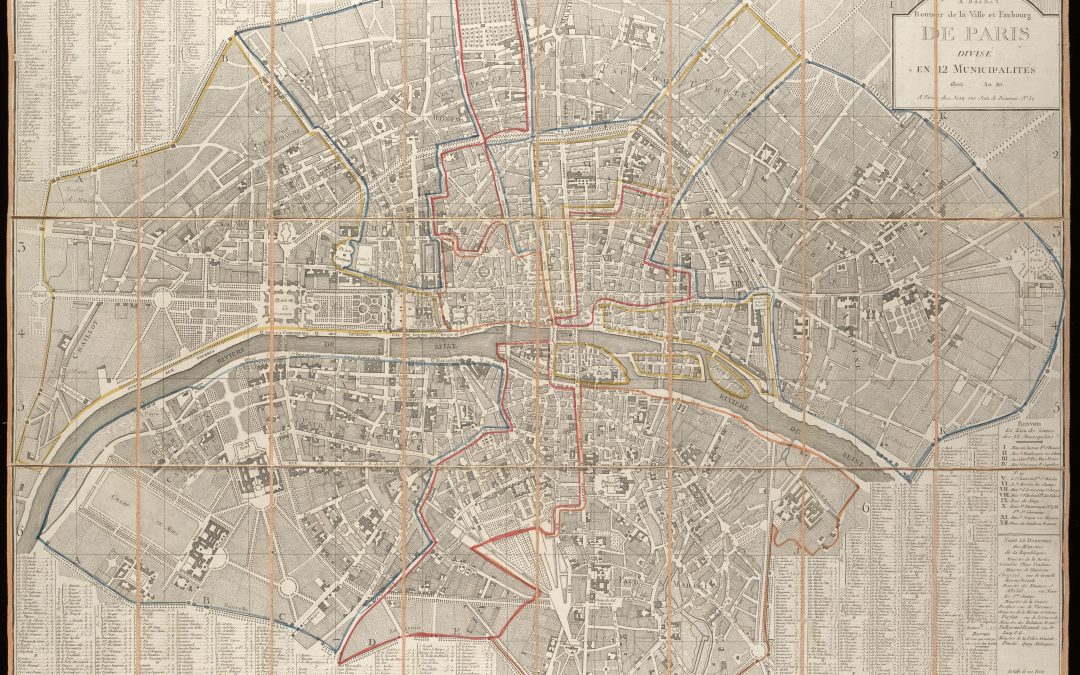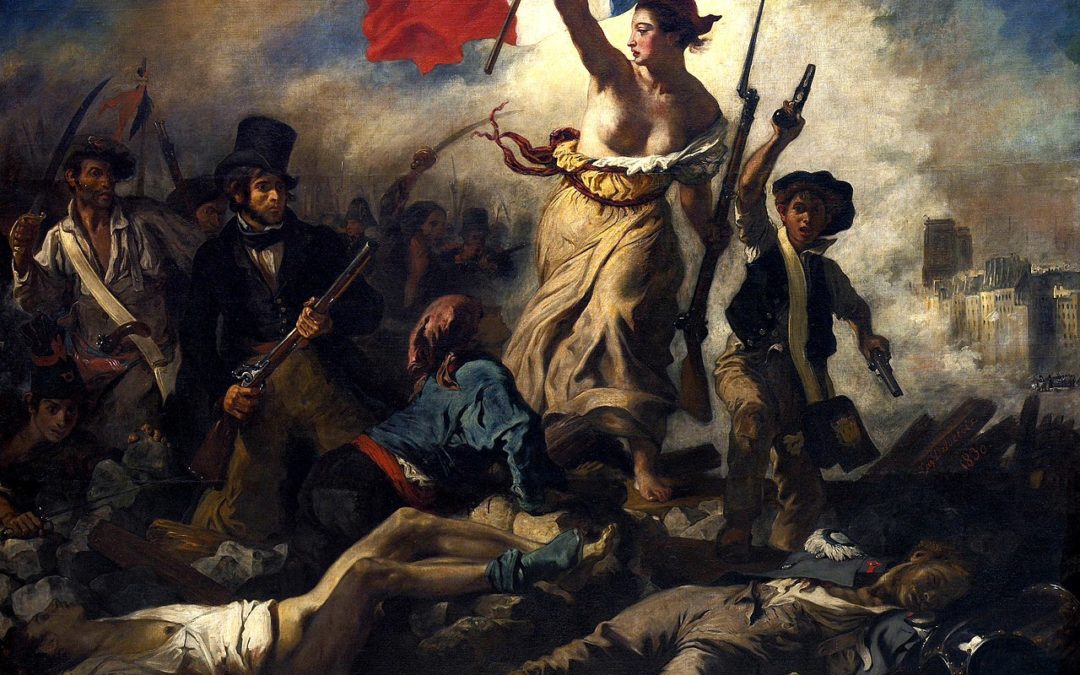
Louvre Museum (Musée du Louvre)
The Louvre Museum is the biggest museum in the world. Some in New York may beg to differ, but the Louvre is the biggest. Wait until you see it in person – from the outside and from the inside. Then you can decide for yourself if it is the biggest. At around 5 football fields long, it dominates the scenery along much of the Seine. You can see it from many of the bridges crossing the river. The architectural style of the exterior changed as additions were made, and sometimes the vast exterior walls may trick you into thinking it is a different building, but, it isn’t. The Louvre is really that big.
Not only is it big, but all the parts of the Louvre are GRAND. The courtyards are enormous, some of the galleries are immense, some paintings and stone sculptures are gigantic! Even the roof and ceilings are endless. Subtle and sublime details are grand as well. Worn marble stairs look and feel soft. Carvings and reliefs fill the rooms and corridors. Vaulted passageways designed with minute details and all parts mesh to make the building a work of art unto itself.
The Louvre: From Fortress and Prison to Royal Palace
The Louvre began as a medieval fortress on the edge of the city for protection and as a prison. Go underground (Level -1) in the Sully wing to see the remnants of the original 12th century structure. Eventually, the Louvre became a royal palace and home to the kings of France. After many years as a working palace, the Louvre became a museum in 1793. Not just any museum, but THE museum all other museums aspired to become. The royal history of the art collection can be seen on the identification tags next to the works of art – look for, “from the collection of Louis XIV,” or choose a monarch and you will probably find the name. Pretty impressive, huh?
With so many years as a royal residence, it has seen more palace intrigue than will ever be written. The escapades in the dark hallways and stairs are unimaginable. As you walk on a far-flung set of steps, think of how dark it would be in the middle of the night. Imagine a royal family member or one of the court ringing a bell and a servant scurrying in the night, holding only a single candle, into the deep dark recesses of the palace. Then trying to find the right door, trying to locate the bell ringer. After attending to the royalty and collecting the slop jar (or for whatever the necessity in the middle of the night), the servant would creep along to make his or her way out of the maze of steps and hallways and back to the workers’ quarters. Who knows what could have been lurking in the shadows on just that one errand?
A Palace Now for Priceless Art and Gardens
Now the servants are gone, but the Louvre employs thousands of people to make your experience in the historic royal palace memorable and safe. They help visitors navigate through the collection, making sure priceless artworks remain untouched, pointing out the location of the toilets and generally guaranteeing the collection remains intact.
The Louvre’s official websites states that its collection includes, “Western artworks from the Middle Ages to 1848, as well as the art of the ancient civilizations that preceded and influenced them. Some 35,000 artworks are on display, the oldest of which date back over seven thousand years.” (Just an FYI, the Musée d’Orsay picks up at 1849.) Not to mention, the building itself is an architectural work of art whose construction spans the 12th to the 21st centuries.
Visit the Louvre with a Plan
The Louvre will be impressive even if you do not go inside. But, if you decide to go in, make a plan for what you will do once you get into the museum. Besides being the biggest museum in the world, the art and artifacts are of unsurpassed quality and by the most important artists and civilizations in history. That means it is generally a mob scene and completely overwhelming. It is easy to get lost in the crowds and move into areas that you are not really interested in seeing. That is disastrous in such a magnificent museum.
A great introduction to the Louvre is to pick one of the “visitor trails” that the Louvre website provides online and do a self-guided walking tour. Each trail has specific instructions to lead you through the Louvre to 10 or so world-renowned works of art. The trails take about an hour from start to finish, depending on how long you linger in admiration and whether or not you get sidetracked. That time does not include going through security and getting into the reception area of the museum. Then add on getting your bearings and going through the line to purchase a ticket or through the ticket-checker line if you already have a paper ticket or museum pass.
See the Classic Masterpieces, a Special Exhibit, or Both
The “Masterpieces” trails are a terrific introduction to the Louvre. One masterpiece trail is accessible for all, and the other is for those who choose to take the steps. The Louvre site also suggests other trails that are tailored to more specific interests. There is even a Da Vinci Code trail! Take a look.
Buy your tickets in advance. Once you make it past security, there are lines going into each wing for those who have tickets, and there are lines to purchase tickets from a ticket machines or an actual person. Get in the correct line.
Also to note, if there is a special exhibition that you want to see that has timed entry and requires a special ticket, ensure you purchase tickets for that exhibit. Once, I bought tickets online for a Vermeer show, way in advance. I checked the tickets, thought they were for the exhibition, guarded them in my satchel all the way to Paris, and when I got to the entrance, the guard told me that my ticket was for general admission to the Louvre – not to the exhibition. Beware! Check your tickets!
Putting this on your calendar? Remember, you may only spend an hour looking at the art, but take into consideration the time it takes to get in, go through security, then get in line to go in, go to the bathroom and finally get to your starting point. Plan accordingly.
The Louvre: Make Your Plan
What makes it special: What doesn’t make it special?
Nearest Métro: Two stops serve the Louvre. Exiting at Louvre-Rivoli, you will be at the eastern-most end of the Louvre. Exiting at Palais-Royal–Musée du Louvre, you will be closer to the pyramid entrance and very close to the entrance at the Passage de Richelieu (if they will let you in) and the entrance through the Carousel de Louvre – kind of underground shopping area that leads you to the main entrance under the pyramid.
Nourishment: Food and drink options are available inside the Louvre in various locations – enjoy a baguette sandwich overlooking the entrance while watching the people come down the stairs under the pyramid!
Arrondissement: 1st
Hours: Wednesday – Monday from 9 a.m. to 6 p.m.; Night opening until 9:45 p.m. on Wednesdays and Fridays
CLOSED ON TUESDAYS
Also closed: January 1, May 1 and December 25
Official website: https://www.louvre.fr/en/
Suggested time to visit: As soon as it opens or in the evenings on the days it is open late
Change as of August 2019: If you have a museum pass, you must now reserve a time to enter the Louvre. You can always buy timed entry tickets online as well.
You may also be interested in one of the lesser known museums in Paris, such as Musée Picasso Paris, Musée Marmottan Monet or Musée Rodin. See the article on “15 Lesser-Known Museums in Paris” for more details here.


